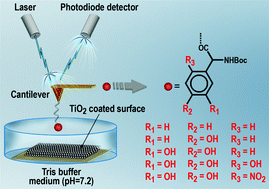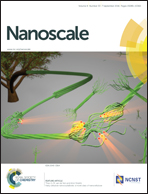Revealing the role of catechol moieties in the interactions between peptides and inorganic surfaces†
Abstract
Catechol (1,2-dihydroxy benzene) moieties are being widely used today in new adhesive technologies. Understanding their mechanism of action is therefore of high importance for developing their applications in materials science. This paper describes a single-molecule study of the interactions between catechol-related amino acid residues and a well-defined titanium dioxide (TiO2) surface. It is the first quantified measurement of the adhesion of these residues with a well-defined TiO2 surface. Single-molecule force spectroscopy measurements with AFM determined the role of different substitutions of the catechol moiety on the aromatic ring in the adhesion to the surface. These results shed light on the nature of interactions between these residues and inorganic metal oxide surfaces. This information is important for the design and fabrication of catechol-based materials such as hydrogels, coatings, and composites. Specifically, the interaction with TiO2 is important for the development of solar cells.


 Please wait while we load your content...
Please wait while we load your content...